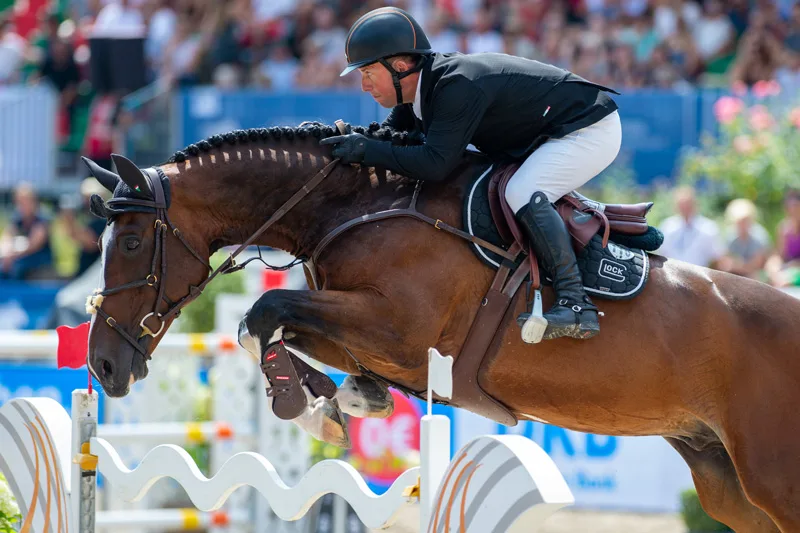Glock’s Zaranza pricks his ears and pulls on the reins as he hones in on a jump. The dark bay gelding clears the grand prix fences in fluid fashion when Dutch Olympic medalist Gerco Schröder guides him around international grand prix tracks. But 2 ½ years ago, whether he would finish a round without a fault wasn’t the biggest question facing “Zaranza.” Instead, his team waited anxiously to learn whether he would survive the night.
The Dutch Warmblood (Karandasj—Santa Caterina, Heartbreaker) started jumping in Fédération Equestre Internationale classes with Austria’s Robert Puck in 2012. He campaigned him in a handful of CSI5* classes before owner Gaston Glock gave Schröder the ride in November 2014.

Glock’s Zaranza and Gerco Schröder at the 2018 Longines Global Champions Tour of Berlin. Thomas Reiner Photo
The pair quickly found their rhythm, picking up good ribbons and globetrotting in sync with the international sporting calendar. But at the end of August 2016 “Zaranza” suffered a near-fatal case of colic.
“At the beginning it was just the question of keeping him alive; no one was talking about bringing him back to the sport because it wasn’t possible,” said Schröder’s groom Alexandre Deramaudt.
They took Zaranza to Tierklinik Telgte Veterinary Clinic for Horses in Telgte, Germany, where he underwent surgery to fix two meters of entrapped small intestine.
“Immediately after surgery his general condition developed well, and he responded well to the treatments,” said Dr. Hilde Skowronek, Zaranza’s veterinarian. “But after 24 hours he started colicking again, and after further diagnostic examinations we decided to perform a second surgery.
“The [trapped] intestines did not recover as hoped, and it was necessary to resect nearly two meters of jejunum,” Skowronek continued. “Even [though] it was the second [surgery] for him he woke up fast and stood up well.”
Veterinarians kept a close watch on Zaranza after his second surgery, monitoring his heart rate, respiratory rate and intestinal sounds every hour, as well as performing additional blood tests several times daily.
“At the same time, he got infusions, antibiotics and medications that stimulate the motility of the intestines and painkillers,” said Skowronek. “The most critical part of the recovery was the feeding, because if you feed [too much] too fast there is the risk that the food gets stuck at the swollen, and maybe narrowed, part of the resection [just before the suture].
ADVERTISEMENT
“After several hours we started feeding him small amounts of soft food such as mash and grass,” Skowronek added. “We slowly increased the amount of food on a daily basis and started adding hay.”
Weeks passed before he was stable enough to leave the clinic, but his challenges weren’t over.
Turnout wasn’t an option, so Zaranza walked in hand twice a day to help regain his strength. But he developed an abdominal hernia, so he returned to the clinic, where he remained through Christmas.
“This is the main risk after a second abdominal surgery because the big muscles and the suture of the abdomen get weaker and can’t bear the weight of the heavy intestines like before,” said Skowronek.
“The abdominal suture was inflamed and weak, so he needed special care of the suture,” Skowronek continued. “After the suture was healed he got his special sized girth to keep his belly as tight as possible. We tried for several weeks to stabilize the abdomen with the girth; he wore it every day for several hours as long as it was comfortable for him.”
But the girth wasn’t enough. An additional three meters of small intestine became trapped in the abdominal hernia, and Zaranza started to colic again.
“The third colic surgery was performed; the intestines were put back in place, and the ruptured scar from the previous surgeries was cleaned up and sutured with a special suture material,” said Skowronek. “He recovered fast, still wearing his belly girth and getting all the care he needs.”
Zaranza was cleared to return to light work in December of 2016. He began with brief periods of trot, and as time went on the length of his workouts increased. Schröder started cantering him and slowly added small jumps to their routine.
“I think he had to really recover, and that took time,” said Schröder. “He needed to be strong enough to start, and when I could start riding he only got better and fresh again.”
ADVERTISEMENT
Glock’s Zaranza back in training, courtesy of Glock Horse Performance Center:
In March 2017, Zaranza got back into the swing of things at the Mediterranean Equestrian Tour in Spain. Within a year, he’d recovered enough to contest five-star competitions, and in 2018, they picked up 11 top-10 placings in FEI competition. Now 15, the stallion appears to be in the best form of his life.
“He’s a very good horse,” said Schröder. “He’s very careful and has a very good mentality. The thing is he’s a sensitive horse but has a lot of quality, so I think it’s good that he got some time to develop.”
But for Schröder, he’s just happy to have Zaranza back.
“I really like the horse and his quality and mind,” he said. “For me, he’s a really special horse.”
Watch Glock’s Zaranza fully back in action in 2018, courtesy of Glock Horse Performance Center:
Do you know a horse who returned to the competition ring after what could have been a career-ending injury or illness? Email Kimberly at kloushin@coth.com with their story.















